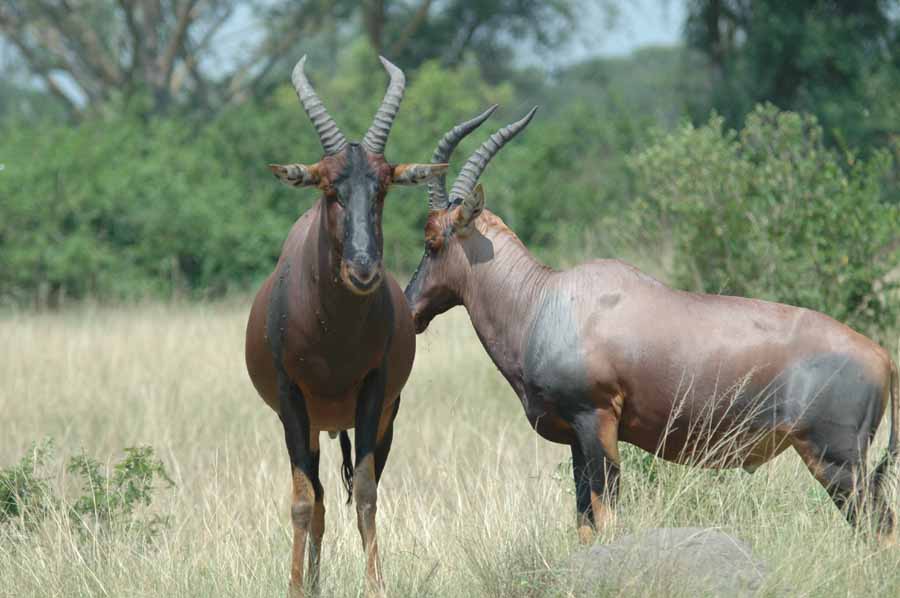| «Back to Previous Post |
Date: Thursday, 3 July 2008 03:53 PDT
Subject: Greetings from Queen Elizabeth National Park, Uganda
Captions for Pictures:
1. Our guide, Martin, and our safari vehicle
2 – 7. Animals we saw during our two-hour boat cruise on the river in Queen Elizabeth National Park
8 – 10. Animals we saw in the Ishasha savanna portion of Queen Elizabeth National Park
It’s Monday at 7AM on 30th June. Sandy and I are currently at Ishasha Bush Camp in Queen Elizabeth National Park, just a few minutes from Uganda’s border with the Democratic Republic of Congo (DRC). The camp is perched on the Ntungwe River which is fast moving and deep brown in color. Besides birds and animal sounds far off, we saw a troupe of baboons from across the river. Sandy and several other guests were awakened last night by the sound of a lion’s roar and the trumpet of an elephant. I slept right through it. This morning, we are hearing the barking sound of the baboons along with the calls of hundreds of birds.
Our tent is the luxury model with running water, a chemical toilet, solar-powered lights and a shower. Before you take a shower, you must order water. The men come 20 minutes later with a large container of hot water and then pour it into a reservoir found at the back of the tent. The main room is spacious large enough for two queen beds though ours has just two twins. The path that leads to our tent is covered with crushed gravel. And, at night, the staff lights this path with kerosene lamps that hang from wrought iron poles. The caretakers, Dave and Karen, operate from the office tent where you check in. There’s a lounge tent where there are chairs and magazines to read. Finally, there’s the dining tent which opens to a large patio. The kitchen is behind a bamboo screen. The menu and dining time were fixed. Sandy and I celebrated our anniversary last night with a glass of red wine from South Africa with our excellent four course meal.
We left Entebbe on Saturday morning and drove about seven hours to Mbarara where we stopped for lunch. We continued on for another three hours before entering Queen Elizabeth National Park. All of the roads were paved on the way to the park but all the roads in the park so far have been dirt. It was market day in many of the towns that we passed. There were mostly fruit and vegetables for sale and lots of activity. As we got closer to the park, the elevation increased and we found ourselves driving through the tea fields of the highland country. Here, the population density dropped with most of the people located close to the road. It was nice to wave back to the children who waved to us as we passed by.
On Saturday night, we dropped our bags at the Mweya Safari Lodge and got a ride down to the jetty for a two-hour boat cruise on a river that connects Lake Edward and Lake Albert. The animals in the area surrounding the lake were prolific. We literally saw thousands of animals during our trip including, hippos, elephants, water buffalos, crocs, several types of antelope and warthogs plus tons of birds, including fish eagles, storks, pelicans, herons, ducks, swallows, kingfishers. We learned that Queen Elizabeth Park was created after sleeping sickness struck in the area and caused all of the areas residents to leave. The park is classified as a biosphere meaning that small fishing villages are allowed to remain in the park. We have attached some of the pictures from this cruise, both of the animals and the human residents.
The next day, we traveled three hours down a long, dusty dirt road. Unfortunately, we lost one of the tires on a sharp rock and were forced to change it at noon in the hot sun (no AAA service here!). Along the way, we saw men in trucks, people on bikes and even some on foot. The road was 70km (43 miles) long with no services. During this stretch, the terrain changed from savanna to rich rain forest and back to savanna.
At noon, we stopped for lunch (packed by the lodge that morning). Afterwards, we took a game drive and saw many of the same animals in a classic African savanna setting: elephants, water buffalos, several types of antelopes, wart hogs and vultures. However, this part of the parks main attraction, the tree climbing lions, was nowhere to be found. Our guide, as well as the caretaker at our bush camp, believes that their routine has been disturbed by the crews of men that have started oil exploration inside the park. It has been reported that there are definitely oil reserves in the park. The only question was how to extract it. In such a small country and with oil forecasted at as high as $150 per barrel in the coming years, Uganda has a difficult decision to make the trade-off between the economic benefits of tourism vs. the hope of improved energy independence and oil revenue.
Today, we will leave Queen Elizabeth Park and travel three hours over dirt roads to Bwindi National Park. Our focus there will be the mountain gorilla. More about this in our next email.
Darren and Sandy
| «Back to Previous Post |










